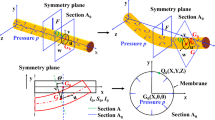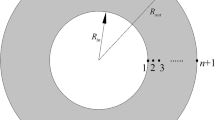Abstract
Inflatable space structures may undergo the vibration of a long duration because of their features of dynamic deployment, high flexibility, and low-frequency modes. In this paper, a topology optimization methodology is proposed to reduce the vibration of a spinning inflatable structure. As the first step, a variable-length shell element is developed in the framework of arbitrary Lagrange-Euler (ALE) and absolute nodal coordinate formulation (ANCF) to accurately model the deployment dynamics of the inflatable structure. With the help of two additional material coordinates, the shell element of ALE-ANCF has the ability to describe the large deformation, large overall motion, and variable length of an inflatable structure. The nonlinear elastic forces and additional inertial forces induced by the variable length are analytically derived. In the second step, a topology optimization procedure is presented for the dynamic response of an inflatable structure through the integration of the equivalent static loads (ESL) method and the density method. The ESL sets of the variable-length inflatable structure are defined to simplify the dynamic topology optimization into a static one, while the density-based topology optimization method is used to describe the topology of the inflatable structure made of two materials and solve the static optimization problem. In order to obtain more robust optimization results, sensitivity analysis, density filter, and projection techniques are also utilized. Afterwards, a benchmark example is presented to validate the ALE-ANCF modeling scheme. The deployment dynamics and corresponding topology optimization of a spinning inflatable structure are studied to show the effectiveness of the proposed topology optimization methodology.

摘要
空间充气结构因其具有可展开、大柔性, 以及低频模态等特性, 常常会产生难以消除的振动. 本文提出了一种空间自旋充气结构振动抑制的拓扑优化设计方法, 该方法首先采用任意拉格朗日-欧拉(ALE)描述的绝对节点坐标(ANCF)薄壳单元建立可展开空间充气结构的动力学模型. 通过引入两个物质坐标, 建立的ALE-ANCF薄壳单元可精确描述充气结构的大范围运动、大变形与变长度等特性. 本文还推导了该薄壳单元的非线性弹性力和由于变长度引起的附加惯性力的解析表达式. 此外, 综合利用等效静载荷法和变密度法, 本文提出了一种可展开空间充气结构动响应拓扑优化方法, 等效静载荷用以将动响应优化问题转化为静响应优化问题, 而变密度法用以描述双材料充气结构的拓扑并求解相应的静响应拓扑优化问题. 为了得到更加稳健的优化结果, 综合了灵敏度分析、密度过滤和密度映射等技巧. 最后, 通过一个基准算例验证了ALE-ANCF模型的正确性, 并研究了空间自旋充气结构的展开动力学与拓扑优化设计, 从而验证了该方法可以抑制可展开空间充气结构的振动.
Similar content being viewed by others
References
M. Schenk, A. D. Viquerat, K. A. Seffen, and S. D. Guest, Review of inflatable booms for deployable space structures: Packing and rigidization, J. Spacecraft Rockets 51, 762 (2014).
D. Lichodziejewski, R. Cravey, and G. Hopkins, in Inflatably deployed membrane waveguide array antenna for space: Proceedings of 44th AIAA/ASME/ASCE/AHS/ASC Structures, Structural Dynamics, and Materials Conference, Norfolk, 2003.
N. Katsumata, M. C. Natori, and H. Yamakawa, Analysis of dynamic behaviour of inflatable booms in zigzag and modified zigzag folding patterns, Acta Astronaut. 93, 45 (2014).
M. Di Capua, D. Akin, and K. Davis, in Design, development, and testing of an inflatable habitat element for NASA lunar analogue studies: Proceedings of 41st International Conference on Environmental Systems, Portland, 2011.
J. Sun, E. Chen, T. Chen, and D. Jin, Spin dynamics of a long tethered sub-satellite system in geostationary orbit, Acta Astronaut. 195, 12 (2022).
H. Fang, M. Lou, and J. Hah, Deployment study of a self-rigidizable inflatable boom, J. Spacecraft Rockets 43, 25 (2006).
A. Clem, S. Smith, and J. Main, in A pressurized deployment model for inflatable space structures: Proceedings of 41st Structures, Structural Dynamics, and Materials Conference and Exhibit, Atlanta, 2000.
L. Lampani, and P. Gaudenzi, Numerical simulation of the behavior of inflatable structures for space, Acta Astronaut. 67, 362 (2010).
E. S. Lee, and S. K. Youn, Finite element analysis of wrinkling membrane structures with large deformations, Finite Elem. Anal. Des. 42, 780 (2006).
H. Liu, C. Wei, Y. Zhao, S. Li, and C. Tan, in Dynamic analysis of the inflatable net system for space capture: Proceedings of 9th International Conference on Mechanical and Aerospace Engineering (ICMAE), Budapest, 2018.
Y. Hong, W. Yao, Y. Xu, and T. Fang, Research on the folding patterns and deployment dynamics of inflatable capsule structures, J. Aerosp. Technol. Manag. 10, (2018).
J. E. Suh, T. H. Kim, and J. H. Han, New approach to folding a thin-walled Yoshimura patterned cylinder, J. Spacecraft Rockets 58, 516 (2021).
J. Xing, Y. Luo, J. Zhan, and Z. Kang, Global shape optimization of fixtures to suppress wrinkles in large-displacement membrane structures, Int. J. Solids Struct. 144–145, 301 (2018).
Y. Luo, J. Xing, Y. Niu, M. Li, and Z. Kang, Wrinkle-free design of thin membrane structures using stress-based topology optimization, J. Mech. Phys. Solids 102, 277 (2017).
N. Li, H. Peng, and F. Li, Instantaneous optimal control of inflatable folded structures, Acta Astronaut. 195, 52 (2022).
J. Sun, Q. Tian, and H. Hu, Topology optimization of a three-dimensional flexible multibody system via moving morphable components, J. Comput. Nonlinear Dyn. 13, 021010 (2018).
J. Sun, Q. Tian, H. Hu, and N. L. Pedersen, Topology optimization of a flexible multibody system with variable-length bodies described by ALE-ANCF, Nonlinear Dyn. 93, 413 (2018).
O. Sigmund, and K. Maute, Topology optimization approaches, Struct. Multidisc. Optim. 48, 1031 (2013).
E. Tromme, A. Held, P. Duysinx, and O. Brüls, System-based approaches for structural optimization of flexible mechanisms, Arch. Computat. Methods Eng. 25, 817 (2018).
S. Zargham, T. A. Ward, R. Ramli, and I. A. Badruddin, Topology optimization: A review for structural designs under vibration problems, Struct. Multidisc. Optim. 53, 1157 (2016).
M. Jiang, X. Rui, W. Zhu, F. Yang, and Y. Zhang, Optimal design of 6-DOF vibration isolation platform based on transfer matrix method for multibody systems, Acta Mech. Sin. 37, 127 (2021).
W. Yao, L. Yang, and M. Guo, Gauss optimization method for the dynamics of unilateral contact of rigid multibody systems, Acta Mech. Sin. 37, 494 (2021).
E. Tromme, O. Brüls, and P. Duysinx, Weakly and fully coupled methods for structural optimization of flexible mechanisms, Multi-body Syst. Dyn. 38, 391 (2016).
H. A. Lee, and G. J. Park, Nonlinear dynamic response topology optimization using the equivalent static loads method, Comput. Methods Appl. Mech. Eng. 283, 956 (2015).
C. Liu, Q. Tian, D. Yan, and H. Hu, Dynamic analysis of membrane systems undergoing overall motions, large deformations and wrinkles via thin shell elements of ANCF, Comput. Methods Appl. Mech. Eng. 258, 81 (2013).
J. Sun, Q. Tian, H. Hu, and N. L. Pedersen, Axially variable-length solid element of absolute nodal coordinate formulation, Acta Mech. Sin. 35, 653 (2019).
M. Arnold, and O. Brüls, Convergence of the generalized-α scheme for constrained mechanical systems, Multibody Syst. Dyn. 18, 185 (2007).
J. Sun, Q. Tian, H. Hu, and N. L. Pedersen, Simultaneous topology and size optimization of a 3D variable-length structure described by the ALE-ANCF, Mech. Mach. Theor. 129, 80 (2018).
E. Andreassen, A. Clausen, M. Schevenels, B. S. Lazarov, and O. Sigmund, Efficient topology optimization in MATLAB using 88 lines of code, Struct. Multidisc. Optim. 43, 1 (2011).
K. Svanberg, The method of moving asymptotes—a new method for structural optimization, Int. J. Numer. Meth. Eng. 24, 359 (1987).
O. Sigmund, Morphology-based black and white filters for topology optimization, Struct. Multidisc. Optim. 33, 401 (2007).
F. Wang, B. S. Lazarov, and O. Sigmund, On projection methods, convergence and robust formulations in topology optimization, Struct. Multidisc. Optim. 43, 767 (2011).
C. Liu, Q. Tian, and H. Hu, New spatial curved beam and cylindrical shell elements of gradient-deficient Absolute Nodal Coordinate Formulation, Nonlinear Dyn. 70, 1903 (2012).
R. A. Arciniega, and J. N. Reddy, Tensor-based finite element formulation for geometrically nonlinear analysis of shell structures, Comput. Methods Appl. Mech. Eng. 196, 1048 (2007).
J. G. de Jalón, Twenty-five years of natural coordinates, Multibody Syst. Dyn. 18, 15 (2007).
Acknowledgements
This work was supported by the National Natural Science Foundation of China (Grant Nos. 12002153, 11827801, and 11832005), the Natural Science Foundation of Jiangsu Province (Grant No. BK20200434), and the Fundamental Research Funds for the Central Universities (Grant No. NS2021003).
Author information
Authors and Affiliations
Corresponding author
Additional information
Author contributions
Jialiang Sun and Dongping Jin investigated the research. Jialiang Sun created the models, performed the simulation, processed the data and wrote the first draft of the manuscript. Dongping Jin and Haiyan Hu revised and edited the final version. Haiyan Hu acquired the financial support for the project leading to this publication and oversighted the research activity planning and execution.
Rights and permissions
About this article
Cite this article
Sun, J., Jin, D. & Hu, H. Deployment dynamics and topology optimization of a spinning inflatable structure. Acta Mech. Sin. 38, 122100 (2022). https://doi.org/10.1007/s10409-022-22100-x
Received:
Accepted:
Published:
DOI: https://doi.org/10.1007/s10409-022-22100-x




